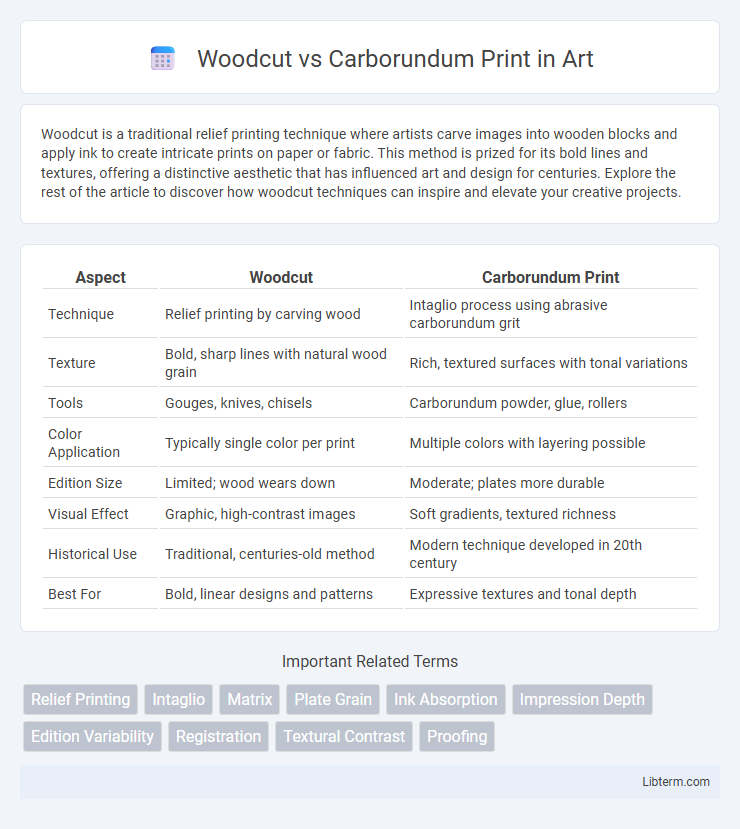Woodcut is a traditional relief printing technique where artists carve images into wooden blocks and apply ink to create intricate prints on paper or fabric. This method is prized for its bold lines and textures, offering a distinctive aesthetic that has influenced art and design for centuries. Explore the rest of the article to discover how woodcut techniques can inspire and elevate your creative projects.
Table of Comparison
| Aspect | Woodcut | Carborundum Print |
|---|---|---|
| Technique | Relief printing by carving wood | Intaglio process using abrasive carborundum grit |
| Texture | Bold, sharp lines with natural wood grain | Rich, textured surfaces with tonal variations |
| Tools | Gouges, knives, chisels | Carborundum powder, glue, rollers |
| Color Application | Typically single color per print | Multiple colors with layering possible |
| Edition Size | Limited; wood wears down | Moderate; plates more durable |
| Visual Effect | Graphic, high-contrast images | Soft gradients, textured richness |
| Historical Use | Traditional, centuries-old method | Modern technique developed in 20th century |
| Best For | Bold, linear designs and patterns | Expressive textures and tonal depth |
Introduction to Printmaking Techniques
Woodcut and Carborundum print are two distinct printmaking techniques that offer unique textures and visual effects. Woodcut involves carving an image into a wooden block, where raised areas hold ink for transfer onto paper, producing bold and graphic prints. Carborundum print, on the other hand, uses abrasive Carborundum grit applied to a plate, creating rich tonal variations and textured surfaces ideal for expressive and detailed artworks.
What is Woodcut Printing?
Woodcut printing is a relief printmaking technique where artists carve an image into the surface of a wooden block, removing the non-printing areas so that the remaining raised parts hold the ink. This traditional method emphasizes strong contrasts and bold lines, making it ideal for creating graphic and textured prints. The technique requires precision in carving and careful application of ink to produce detailed, high-contrast artworks.
What is Carborundum Printing?
Carborundum printing is a unique intaglio technique that uses silicon carbide grit to create textured printing plates, offering rich tonal variations and a distinctive surface quality. Unlike traditional woodcut prints, which rely on carving into woodblocks to produce bold, graphic images, carborundum prints achieve softer gradients and intricate details through a combination of abrasive materials and ink retention. This method allows artists to explore varied textures and expressive depth, making it ideal for experimental and abstract artworks.
Historical Background of Woodcut and Carborundum
Woodcut printing dates back to ancient China around the 9th century and became a prominent technique in Europe during the 15th century, playing a crucial role in early book illustration and mass communication. Carborundum printmaking, invented in the 1930s by Henri Goetz, emerged as a modern intaglio process using abrasive silicon carbide powder to create rich textures on printing plates. Both methods reflect distinct historical advances in printmaking, with woodcut rooted in early relief techniques and carborundum representing innovative 20th-century experimentation.
Materials and Tools: Woodcut vs Carborundum
Woodcut printmaking primarily uses a hardwood block, such as cherry or maple, and tools like gouges and chisels to carve the image, creating relief prints. Carborundum printmaking involves applying a gritty substance made from silicon carbide powder mixed with an adhesive onto a plate, usually copper or aluminum, to create textured surfaces for intaglio printing. The distinct materials and tools directly affect the texture and detail achievable in each technique, with woodcut offering bold, graphic lines and carborundum producing rich, tonal variations.
Artistic Styles and Visual Effects
Woodcut printmaking features bold, high-contrast lines created by carving into a wooden block, producing stark, graphic images with a strong sense of texture and linear detail. Carborundum printmaking employs abrasive grit to create rich, velvety textures and subtle tonal gradations, resulting in softer, more painterly effects that emphasize depth and mood. Artists choose woodcut for its dynamic, sharp-edged compositions and carborundum for expressive, atmospheric visuals with nuanced shading.
Comparing Creative Process and Workflow
Woodcut printmaking involves carving a design into a wooden block, requiring meticulous planning and precision to create bold, textured images through relief printing. In contrast, carborundum printmaking utilizes abrasive materials to build texture on a plate, offering a more experimental and painterly workflow with greater flexibility in tonal variation. The woodcut process is labor-intensive with a focus on subtractive techniques, while carborundum allows additive approaches, making it ideal for artists seeking dynamic surface depth and complex layering in their prints.
Durability and Edition Sizes
Woodcut prints feature durable wooden blocks that can withstand large edition sizes, often producing hundreds of consistent impressions before the block shows wear. Carborundum prints, created using a mixture of abrasive grit and adhesive on a plate, typically result in smaller edition sizes due to the delicate nature of the texture and the potential for plate degradation. The longevity of woodcut blocks surpasses that of carborundum plates, making woodcut ideal for extensive print runs with consistent quality.
Pros and Cons: Woodcut vs Carborundum
Woodcut prints offer sharp, bold lines and a traditional aesthetic, with the advantage of durability and ease of reproduction, but they often lack subtlety and tonal variation. Carborundum prints provide rich textures and a wide range of tones, allowing for more expressive and detailed images, yet the process is time-consuming and materials can be more costly. While woodcut excels in graphic clarity and simplicity, carborundum stands out for depth and painterly effects, making the choice dependent on artistic intent and project requirements.
Which Printmaking Method Should You Choose?
Woodcut printing offers bold, graphic lines with rich texture, ideal for artists seeking a traditional, handcrafted aesthetic using simple tools and relief techniques. Carborundum printmaking produces soft, tonal variations and detailed textures by incorporating abrasive grit on the plate, perfect for creating atmospheric or painterly effects. Choosing between woodcut and carborundum depends on your desired style, level of detail, and the tactile quality you want to achieve in your prints.
Woodcut Infographic

 libterm.com
libterm.com